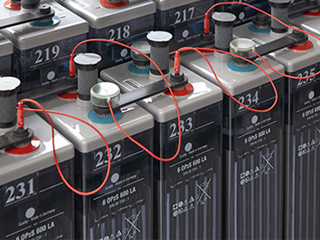What Is Battery Energy Storage Systems (BESS)?
Battery energy storage systems (BESS) are systems that store electrical energy. Renewable sources such as wind and solar farms typically generate this energy. The stored energy is used when demand spikes or if an emergency arises. BESS are employed in data centers as emergency power systems (EPS). Analysts predict the BESS industry to grow to 26 billion dollars by 2026, with lithium-ion (Li-ion) batteries powering 97.8% of systems. In this article we will examine the hazards and dangers of BESS as well as battery fire protection and monitoring systems.
Risks And Hazards Of Battery Energy Storage Systems
There are common dangers that must be handled as part of operation and maintenance. There is the risk of electrical shock and arc flash, as with most electrical equipment. When operating in and near energy storage systems, these should constantly be considered. NFPA 70E, Standard for Electrical Safety in the Workplace, has more advice on how to work safely with electrical equipment.
- Thermal Runaway
The uncontrollable self-heating of a battery cell is known as thermal runaway. It starts when the quantity of heat produced by a battery exceeds the amount of heat that can be dispersed to the environment. The overheated cell then produces flammable and poisonous fumes, which can reach temperatures high enough to ignite them. The word “runaway” comes from the fact that this behavior might spread to neighboring cells and advance through the ESS.
- Off-Gassing
Gases emitted by battery energy storage systems are extremely combustible and poisonous. Gases such as carbon monoxide, carbon dioxide, hydrogen, methane, ethane, and other hydrocarbons are commonly emitted, depending on the battery chemistry involved. There is the possibility of an explosion if the gas reaches its lower explosive limit before finding an ignition source. In 2019, an example of this occurred in Surprise, Arizona.
- Stranded Energy
When a battery has no safe manner of discharging its stored energy, it is referred to be stranded energy. After an ESS fire has been extinguished and the battery terminals have been damaged, this is a regular occurrence. Because the damaged ESS still retains an unknown amount of electrical energy, it poses a shock hazard to anybody dealing with it. Stranded energy can also cause a fire to rekindle minutes, hours, or even days after it first started.
Factors That Causes Battery Fires and Hazards
Batteries can fail in a variety of ways, resulting in fires, explosions, and the release of poisonous chemicals.
- Thermal Abuse
Battery energy storage systems are designed to work in a specific temperature range, which is normally specified by the manufacturer. If the BESS is operated outside of a permissible temperature range, it may not function properly, prematurely age the battery, or possibly fail completely, resulting in fire and explosions. External sources of thermal abuse include contact with a burning or overheating nearby cells, increased temperatures, or exposure to other external heat sources connected with both cell storage and the environment in which the BESS is installed.
- Electrical Abuse
When a battery is overcharged, charged too quickly, or externally short-circuited, it is subjected to electrical abuse. This can also happen if the battery is discharged too quickly or is discharged below the designated end voltage. Electrical abuse can result in a malfunctioning BESS, as well as overheating, fire, and explosion.
- Mechanical Abuse
When a battery is crushed, dropped, pierced, or otherwise distorted to failure by mechanical force, it is said to have been subjected to mechanical abuse.
- Internal Faults
Internal flaws can occur as a result of poor design, low-quality materials, or flaws in the manufacturing process. It’s worth mentioning that lithium-ion cell failure rates are reported to be on the order of one in a million.
- Environmental Impacts
Battery failure can be caused by environmental factors. Extremes in temperature, seismic activity, floods, debris ingress, corrosive mists such as dust or salt fog, or rodent damage to wiring can all cause this. If not well-controlled, dewing can occur in some regions prone to rapid temperature changes, such as in the highlands, causing damage to the ESS situated outdoors.
Stages Of A Battery Energy Storage Systems (BESS) Fire
BESS fires tend to follow a familiar pattern of stages:
- Stage 1
A thermal reaction in a battery cell is triggered by a manufacturing flaw or mechanical, electrical, or thermal abuse.
- Stage 2
Depending on the battery chemistry, the damaged cell begins to overheat and vent traces of CO2, Volatile Organic Compounds (VOC), and other compositions of vent gasses. As a result of the thermal event, incipient smoke may be present. At this point, intervention is required to limit or prevent thermal runaway.
- Stage 3
Thermal runaway cannot be stopped once it has started, but it can be slowed down.
- Stage 4
An explosion and/or fire capable of destroying the BESS and spreading to nearby units.
NFPA Fire Protection Research Foundation Report confirmed that Li-ion batteries use dissolved lithium salts (LiPF6). This is opposed to the free lithium metal that allows water to be used as an extinguishing agent while investigating this fire threat. Of course, the extreme heat could result in a steam explosion, further exacerbating the danger. Water may not be able to reach cells that are hidden or enclosed. This could also do significant damage to electrical and mechanical systems that were not engaged in the incident. Additionally, water may not be available in isolated areas.
Early Warning Sensors For Threat Detection
Battery thermal runaway can be prevented through early threat warning indicators. Effective mitigation approaches can be implemented. Through proper design, monitoring, and active control using early warning smart sensors and appropriate suppression technology. The following sensors are recommended for a BESS:
- Battery Monitoring Systems
Individual batteries’ temperature, voltage, and impedance are monitored, and alerts are sent when limits are exceeded.
- Power Quality Sensors
By assessing and converting power quality into easy and actionable information, it is possible to monitor for electrical abuse.
- Thermal Imaging IR Sensors
Can detect possible hotspots by monitoring battery surface temperatures at up to 9600 distinct places every 2 seconds. They can also be used to keep an eye on things like power distribution units, CPUs, fans, and other mechanical components.
- Liquid / Water Sensors
In a Li-ion BESS, typical coolants are 50 percent ethylene glycol and 50% water. Leaks can be identified and fast action taken with these sensors. Could limit a calamity like the Victorian Big Battery Fire in Australia.
- Gas Sensors For Refrigerant
Can detect leaks from a faulty cooling system.
- Shock & Vibration Sensors
Mechanical abuse is another primary cause of catastrophic battery failures that shock and vibration sensors can detect. Potential mechanical abuse can be identified by capturing vibrations numerous times per second.
Battery Fire Protection With Appropriate Suppression
A fire-suppression system that uses inert gas can be useful. While extracting heat from the flames, it depletes oxygen in the room. Electrically non-conductive gasses such as argon, carbon dioxide, and nitrogen leave no residue to clean up. Suppression can be targeted at specific threat locations. Or applied in a comprehensive flooding application. As long as the chemical fills the container or room. This method can extinguish a fire even if a non-battery component of the BESS is engaged. And without causing water damage or needing post-action cleanup.
Rapidly flooding the BESS with the extinguishing chemical inhibits the production of large volumes of an explosive electrolyte-oxygen combination. This lowers the risk of a thermal runaway and prevents the spread of the fire to nearby battery cells. Once the system is integrated with the ventilation system, it minimizes secondary fires and the risk of re-ignition. This is because the inert gas can remain for an extended time.
What Is The Best Extinguishing Agent To Use?
Hazardous decomposition products may occur, and lengthy discharge may be required. Therefore chemical extinguishing agents cannot be employed in this application scenario. There are three (3) natural extinguishing gasses:
- Nitrogen (N2)
- Carbon Dioxide (CO2)
- Argon (Ar)
Argon is a single-atom molecule that does not react with any other periodic table element. It does not degrade in high-temperature flames, is safe for surrounding equipment, and is effective in extinguishing class A, B, C, and D fires. And this makes it compatible with a variety of battery chemistries. As a result of these factors, Argon is an excellent extinguishing agent for Li-ion battery storage systems.
With renewable energy sources powering the future. It is only critical to have reliable and cost-effective energy storage. Reliable early fire prevention is crucial to minimize total operating costs (TOC) of any critical infrastructure system, such as a BESS.
AKCP Fire Detection And Battery Monitoring System
One of the most impactful decisions for limiting fire damage and preserving the BESS is the chosen method of detection. Various detection options are available to identify the stages of thermal runaway: temperature increase, off-gases, smoke, and flame.
The earlier a malfunctioning battery is detected, the sooner fire suppression systems may activate. However, if suppression systems are not installed, detection is still essential as it can activate HVAC vents to flush out off-gases, sound alarms, and notify emergency responders.
- Smoke Detector
Smoke sensors or detectors use optical sensors or ionization detection to detect the presence of smoke conditions that might be a sign of a fire.
- Siren and Strobe Light
The sensorProbe and securityProbe series base units can include a combined strobe light and siren to add eye-catching audiovisual alarms. When the siren is activated, it emits a loud alarm and a bright flashing strobe light, providing a clear indication of an alarm condition.
It’s ideal for usage in mission-critical scenarios because it’s powered by the base unit and requires no additional power. The siren and strobe can be triggered by the condition of another sensor, or they can be manually controlled using the web interface or using their own SNMP OID.
- Wireless Air Quality Sensors
Air Quality sensors or Gas Sensors, like chemical sensors, are calibrated to detect the presence of combustible, poisonous, or flammable gas in the sensor’s surroundings. The following are some examples of particular gases that can be detected:
-
- Acetone (Ex. Paints And Glues)
- Toluene (Ex. Furniture)
- Ethanol (Ex. Perfume, Cleaning Fluids)
- Hydrogen Sulfide (Ex. Decaying Food)
- Benzene (Ex. Cigarette Smoke)
- Battery Monitoring Sensor
Battery Monitoring Sensor for battery and DC power system voltage, temperature, and current load monitoring.
The Battery Monitoring Sensor keeps track of a single cell or battery bank, as well as DC power systems like solar panel arrays. You can use the Battery Monitoring Sensor to keep track of:
- The temperature of the battery terminals
- The voltage output from batteries or panel array
- Current load on batteries or charging circuit
Reference Links:
https://www.idealenergysolar.com/how-battery-energy-storage-works/
https://www.powermag.com/protecting-battery-energy-storage-systems-from-fire-and-explosion-hazards/
https://www.altenergymag.com/article/2021/09/what-you-need-to-know-about-energy-storage-system-fire-protection/35848
https://www.nfpa.org/News-and-Research/Publications-and-media/Blogs-Landing-Page/NFPA-Today/Blog-Posts/2021/12/03/Battery-Energy-Storage-Hazards-and-Failure





